
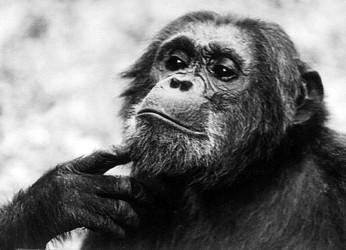
Pan troglodytes schweinfurthii. Portrait of a prime high-ranking wild adult male, Gombe National Park, Tanzania. © 2005
"Chimpanzees have given me so much. The long hours spent with them in the forest have enriched my life beyond measure. What I have learned from them has shaped my understanding of human behavior, of our place in nature."
- Jane Goodall
Introduction
Chimpanzees are a very intriguing species in the animal kingdom. The research that has been done to allow a greater understanding of these individuals began only a few decades ago. They are native to many environments throughout western and central Africa, however, due to rapid deforestation their habitat is quickly becoming depleted, and they are recognized as an endangered species.
Classification
Chimpanzees fall into the Kingdom Animalia, Phylum Chordata, Subphylum Vertebrata, Class Mammalia (warm blooded animals with hair and mammary glands), Order Primates (11 families included such as lemurs and monkeys), Family Pongidae (which are the great apes, including chimpanzees, gorillas, bonobos, and orangutans), Genus Pan (chimpanzees and bonobos), and Species Pan troglodytes. There are three sub species: P. t. verus, P. t. troglodytes and P. t. schweinfurthii.
P. t. verus is found in the western region of their habitat, occurring from Gambia to the Niger River. P. t. troglodytes are found from the Niger River to Congo. P. t. schweinfurthii are found in the most eastern region of their range, from northwest Zaire to western Uganda and Tanzania (All About Chimps, 2008).

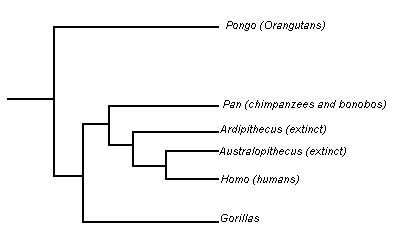
Relationships of Catarrhini genera. © 2007
Evolution and Relationship to Humans
The earliest known primates date to 70 million years ago. The great apes, including the chimpanzee and humans, spilt off from the lesser apes about 20 million years ago (All About Chimps, 2008).
Humans and chimpanzees diverged approximately 6 million years ago, making the chimpanzee the closest extant relative to modern humans, having DNA sequences about 98% identical to each other (Feuk et al., 2005). Through comparison of the two genomes, the genetic differences that have accumulated since the human and chimpanzee diverged from a common ancestor have been catalogued. These changes constitute approximately thirty-five million single-nucleotide changes, five million insertion/deletion events, and various chromosomal rearrangements (The Chimpanzee Sequencing and Analysis Consortium, 2005). Due to the similar nature of the DNA, chimpanzees have been investigated with regard to medical application for humans. Humans and chimpanzees are similar with regard to many aspects of physiology and disease. However, there are several definite and likely differences; such as susceptibility to Alzheimer disease, epithelial cancers, Plasmodium falciparum malaria and the progression of HIV to AIDS. Knowledge of chimpanzee biology remains incomplete, and will continue to provide useful information about the human body (Olson and Varki, 2003)

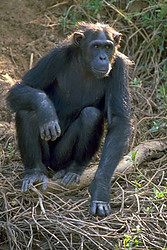
Chimpanzee at Sweetwaters Game Reserve, Kenya. © 2002 California Academy of Sciences
Physical Characteristics/Anatomy
Standing erect chimpanzees are 1 m to 1.7 m tall. Males in the wild weigh between 34 and 70 kg, while females range between 26 and 50 kg. In captivity males can weigh up to 80 kg and females can reach 68 kg. It seems that P. t. schweinfurthii weighs less than P. t. verus, which is smaller than P. t. troglodytes. Chimpanzees have arms that are much longer than their legs. Their arm span is approximately 1.5 times the height of each individual. Their long arms allow chimps to swing from branch to branch, a form of locomotion called brachiation. They also have long fingers and hands but short thumbs. This allows for chimpanzees to hold branches without interfering with the mobility of their thumbs (Shefferly, 2005). Chimpanzees have a cranial capacity of 320-480 cubic centimetres (cc). As a reference, Homo sapiens (modern humans) have a cranial capacity of at least 1400 cc (Billiet, 2005).
Chimpanzees have a slightly prognathic face, meaning that it protrudes. Chimps have very flexible lips, allowing them to carry out many tasks using labial manipulation. Some large individuals may have a sagittal crest, which is a protrusion of bone running lengthwise along the midline of the skull. The sagittal crest indicates incredibly strong jaw muscles.
The dental arc of the chimp has a square shape. They also have an obvious diastema, which is a gap between the front teeth. They have large canines and molars; however, molar size decreases towards the back of the mouth. Chimpanzees have black hair and skin colour varying from pink to black. Chimps have bare skin on their faces, ears, palms of their hands and soles of their feet. Infant chimps often have pale skin and a white tuft of fur on their tail; these features disappear by adulthood. Both sexes tend to lose hair on their heads as they age, showing a bald patch behind the brow ridge. Hairs on their back may also grey with age. The shortness of their thumbs in comparison to their fingers inhibits a precision grip between their thumb and index finger. Chimpanzees use their middle digits and thumb for fine manipulations. They also have opposable big toes, allowing their feet to be used in manipulating objects. In the wild, chimps rarely live longer than 50 years; however some individuals have lived longer than 60 years in captivity. Chimpanzees can suffer from colds, diarrhea, osteoarthritis and even polio is known to affect them (Shefferly, 2005).
Habitat
Chimpanzees are found in 21 African countries. They range from Gambia in the west to Uganda in the east. This excludes areas of central Zaire where their sister species the bonobos (Pan paniscus) are found. Chimpanzees are endangered as the tropical forests where they were most populous are being cut down. Forests are being clear-cut to provide space for human living, agriculture, and domestication of animals. The current estimate of their population size is 100,000-200,000 individuals. They live in rainforests, open woodlands, swamp forest and sometimes the open savannah. Chimpanzees can live in mountain forests that are elevated at 2,750 m above sea level. (All About Chimps, 2008).

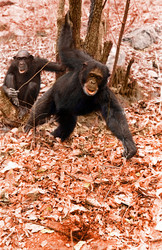
Pan troglodytes schweinfurthii using tools at Gombe National Park. A male chimpanzee dips a long stick into a nest of army ants (Dorylus sp). When sufficient ants had gathered, he transferred the tool to his foot and used his free hand to strip the ants into his mouth. The fiercely biting ants attack anything that moves, so he stands as far from the nest as he can. In the background an old female, tool in hand, awaits her turn. © 2005
Locomotion
Chimpanzees are quadrupeds, usually walking using all fours. They use the soles of their feet and the knuckles of their hands. They have the capability of being bipedal; they can walk upright too, when they need to use their arms to carry objects. Chimps are also very good at climbing trees, where they spend much of their time. They can swing from branch to branch in the trees quickly and safely (All About Chimps, 2008).
Reproduction
Sexual relationships can be limited to the time of estrus, in which males court females, or they may last longer and be related to friendships. Females are more likely to be cooperative if they are involved in a friendship with the male. Chimpanzees are able to reproduce starting between 12 and 13 years of age, and are socially mature shortly afterwards. Female chimpanzees are in gestation for 8.5 to 9 months and most often have a single child. Spacing between births is usually 5 years as there is a great deal of maternal care after the birth (All About Chimps, 2008). Once a baby chimp is 6 months old it can ride on its mother's back, grasping her fur. When a chimpanzee is weaned it will build its own sleeping nest and no longer sleep with its mother. Chimpanzees stay with their mothers for approximately seven years.
Dominant males most often have the most access to females. Low ranking males may however become fathers by leading a female away when she is in that portion of her reproductive cycle where she is not interesting to high ranking males. He will keep her isolated until she is in the fertile part of her cycle. Females are attractive to males when they are at the correct point in their reproductive cycle. They experience a swelling and change in colour of their angoenital region. This swelling lasts about 6 days. There is no seasonality in the reproduction of chimpanzees; it is simply based on the ovulatory cycle of the females.
When a male wants to copulate he often sits with this legs flexed and splayed, displaying his erect penis to a possible mate. The male may also involve himself in piloerection (fluffing of hair). He may also gaze directly at the female; this form of communication serves as an invitation. Males may also shake overhead branches; this serves as a signal for the female to present her hindquarters, allowing them to engage in copulation. A male that fails to attract the attention of a female may outstretch his arms toward the female and stamp his feet or knuckles in a further attempt to be noticed. Copulation most often occurs in a squatting position once the female has presented her rump. Usually, there is no contact between the two when mating, except their genitals (Shefferly, 2008).

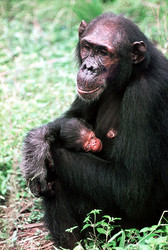
Pan troglodytes schweinfurthii mother with newborn infant. © 2005
Other Behavior
Tool Use
Chimpanzees have been seen using sticks to acquire ants and termites and to scare intruders. They have also been known to sop up water to drink. Chimp culture is similar to human culture in that groups in different areas share varying cultures. The Gombe chimps of Tanzania alter long twigs to use in termite fishing; however, the chimps of the Tai Forest in Cote d’Ivoire are often seen nut-cracking with rocks and planed surfaces. Chimpanzees in the same countries but separate territories exhibit different cultures. Additionally, chimpanzees have been found to use plants medicinally. It has been recorded that they have used 13 different plant genera. These plants have shown anti-tumor and antibiotic properties. Some of these plants are only consumed by chimpanzees that appear ill.
Social Behavior
Chimps are diurnal animals, meaning they are awake during the day. They live in small social units from 40-60 individuals. Chimps spend a great deal of time in the trees, sleeping and feeding on fruits. They construct fresh nests nightly from plant materials. Mothers share their nests with offspring that is unweaned while other juveniles and adults sleep solitarily. Males usually travel further than females each day, on average about 4.9 km/day and females average 3.0 km/day (Shefferly, 2005).
Chimpanzees can easily distinguish between other individuals. They have long memories. This is seen in the fact that those that are taught sign language remember individuals they haven’t seen in years and remember the name sign for them. These long social memories probably play a significant role in chimpanzee society. Chimpanzees have a fusion-fission society. The community splits into small parties that often travel alone. Subgroups rejoin on occasion, making them constantly changing. Members of a community are rarely found together. Males are more social than females, at Gombe, they often travel in larger parties than females. Male parties are usually focused on sexually attractive females. When females are not in estrus they usually travel alone or with their offspring. Occasionally, mothers will travel together letting their young play together (Landau, 2007).
Males become peripheral in late adolescence, spending more time alone. Males may then begin challenging adult males in different communities. Adult males have a linear dominance hierarchy, impacting their behavior. Mature males spend little time isolated from other chimpanzees. Old males sometimes become more solitary as they near death. The alpha male is the dominant male of the group. He is obvious because of his erect hair and hunched shoulders while walking.
Females are more social when their sexual cycles are underway, spending more time with males of neighboring communities. They may transfer to a new community during their sexual cycles. Females associate most with their families after the birth of offspring, except during cycling. Mothers often have friendships with their adult offspring. Friendships are often also formed between adult siblings and also between unrelated males.
Grooming. Grooming not only involves the removal of ticks, dirt and dead skin, but also aids in establishing and preserving social bonds. It is often accompanied by lip smacking, tooth clacking and lip buzzing. Noises that are made by chimps often increase as the grooming chimp finds something in the hairs of the individual it is grooming. Males are found to groom each other more often than females do.
Play. Playing is useful in young chimps because it can help to teach them techniques for survival, but it is often seen in adults as well. Common types of play include tickling, chasing and wrestling which may result in a soft laughter (Landau, 2007).
Aggression. Dominant males often display their aggression and do not have to engage in physical fights, because they can intimidate other males. It has been found that males will actively search out neighboring community members in addition to attacking intruders (All About Chimps, 2008).
Communication. Chimpanzees use communication to teach their young the many skills they need to survive as well as conveying information to other chimpanzees about food, social relationships, distress, and mating. Chimpanzees have a complex system of communication. They have vocal cries that warn other chimps of danger in the area; their danger call can be heard through the forest approximately 2 miles (3 km) away (All About Chimps, 2008). Each individual has a distinctive pant-hoot, so that the caller can be identified with precision. A loud, long, savage-sounding roaring call is made when a chimpanzee comes across something unusual or dangerous. When there is an abundance of food, chimps bark loudly to call the others in their group to a feast. Chimpanzees also use many gestures to indicate needs and emotions. Chimps will beg other chimps for food by approaching them with open hands. Friends may hold hands, hug, or even kiss to show affection. A worried chimp makes a lip-puckering face, while a frightened chimp will bare its teeth. A smile indicates a relaxed, friendly chimp. When the lips are tightly pressed together, the chimp is ready to attack. Male chimpanzees proclaim their dominance with spectacular charging displays during which they slap their hands, stomp their feet, drag branches as they run, or hurl rocks. In doing so, the chimp makes himself look as large as possible so as to intimidate a higher-ranking individual, without having to fight; often actual attacks are not necessary to maintain social order (Shefferly, 2005).

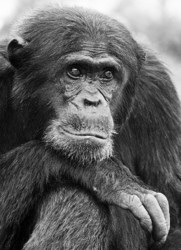
Pan troglodytes schweinfurthii. Portrait of a prime high-ranking wild adult male. Gombe National Park, Tanzania. © 2005
Dietary Habits
Chimpanzees are omnivores, meaning they eat plants as well as meat. They forage for food in the forests during the day, eating leaves, fruit, seeds, tree bark, plant bulbs, tender plant shoots, and flowers. They also eat termites, ants, and small animals, when available; chimpanzees have even been known to eat young monkeys. Successful hunters typically share some portion of their kill with other group members in response to a variety of begging behaviours. Meat is a favoured food item among chimpanzees, but does not make up more than two percent of their overall diet. Meat is not wasted; most of the captured animal is eaten, including the brain (All About Chimps, 2008).

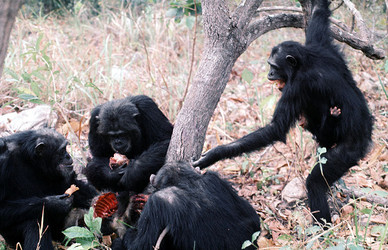
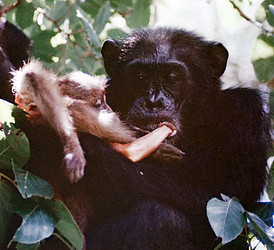
Left: Three male chimps share the carcass of a red colobus (Colobus tephrosceles badius) which they have caught and killed. A female with ventral infant (right) begs for scraps of meat. Right: A male chimpanzee chewing the arm of his prey, a juvenile baboon (Papio anubis). Images © 2005
Experimentation
Chimpanzees have long been used in biomedical research because they are so similar to humans. They have been used to assess the damage done to the skull and brain in impact injuries to the head as well as in studies of social deprivation. Chimpanzees can be infected by almost all known human infectious diseases. They are so like humans that it has become a moral issue as to whether to use them in experiments. The types of experiments as well as their treatment between experiments are often a great source of controversy. There are now many people who object to using animals in testing, especially those that share so many likenesses with humans (Landau, 2007).
Dr. Jane Goodall
Dr. Jane Goodall is a scientist who has spent most of her adult life observing chimpanzees in the wild in Gombe National Park, Tanzania. Her field-work, which lasted from 1960 to 1986, has produced tremendous amounts of information about these social animals whose behavior is very similar to that of humans. When Dr. Goodall started her study of chimpanzees in 1960, very little was known about their behavior in the wild. Since then, many researchers have conducted studies to better understand the chimpanzee’s way of life (Landau, 2007).


Jane Goodall at the TEDGlobal 2007 conference in Arusha, Tanzania. © 2007 Erik (HASH) Hersman
Information on the Internet
- All About Chimps Enchanted Learning. WGBH Educational Foundation.
- Evolution: the Hominids Paul Billiet, The Open Door Web Site.
- Discovery of Human Inversion Polymorphisms by Comparative Analysis of Human and Chimpanzee DNA Sequence Assemblies PLoS Genetics
- All About Chimps Chimpanzee Central. The Jane Goodall Institute.
- Initial Sequence of the Chimpanzee Genome and Comparison with the Human Genome Abstract.
- Sequencing the Chimpanzee Genome: Insights Into Human Evolution and Disease (pdf) Nature Reviews| Genetics
- Pan troglodytes Animal Diversity Web. 2005. University of Michigan Museum of Zoology.





 Go to quick links
Go to quick search
Go to navigation for this section of the ToL site
Go to detailed links for the ToL site
Go to quick links
Go to quick search
Go to navigation for this section of the ToL site
Go to detailed links for the ToL site